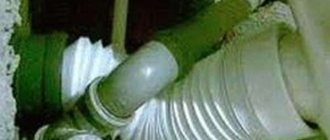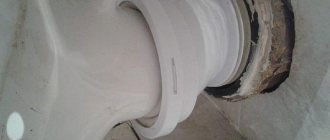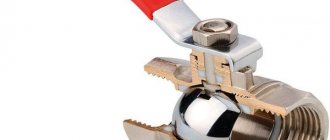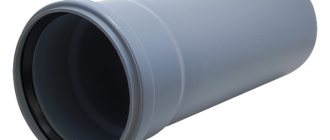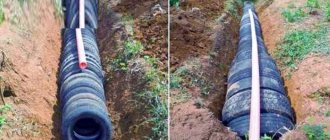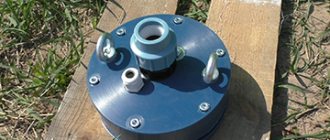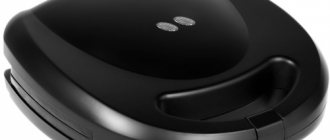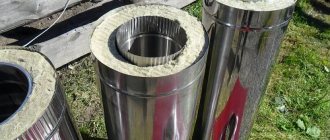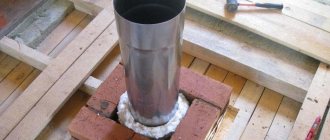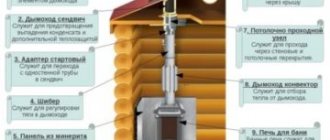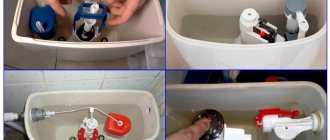A corrugated toilet flush is a transition element for connecting the toilet to the sewerage system. This is a wide pipe with corrugated walls, made of thermoplastic. At one end, the fan pipe has a pipe with a funnel-shaped extension and a seal inside - this side of the pipe is put on the toilet. On the other side there is a pipe with a rubber sealing coupling to facilitate connection to the sewer riser. Thanks to the corrugation, such an adapter can easily be stretched to the desired length and makes it easier to install.
Since ignoring any nuances associated with the sewerage system is fraught with leakage of drains, we will consider in more detail everything you need to know about the correct use of this type of connecting fittings.
What is a toilet corrugation and why is it needed?
An important advantage of corrugated pipes over smooth-walled ones is the ability to give them the desired configuration without collapsing the walls. This potential is in high demand in a wide variety of situations, which is why flexible connecting elements of this design are produced in different lengths and diameters.
A type of corrugated pipe is also a toilet corrugation - a non-pressure fitting, through which the toilet drain pipe is connected to the sewer inlet. The product is a sleeve made of thermoplastic (sometimes with an internal reinforcing coating), the middle part of which has an “accordion” cross-section. One end of the fitting is designed to be inserted into the neck of the sewer pipe, the other is put on the toilet flush.
The design is simple, but in some cases irreplaceable. For example, the toilet was connected to the sewer with a rigid elbow and was dismantled before renovating the bathroom. If the level of the repaired floor has changed, but the sewer pipes have remained the same, it will no longer be possible to connect the device in the same way. In such a situation, the easiest way to connect the toilet to the sewer is to use a corrugated drain.
You cannot do without corrugations even when the sanitary fixture needs to be moved horizontally relative to the sewer pipe. A flexible fitting is also convenient for arranging a temporary toilet during the period of toilet repair.
Types and sizes of corrugated pipes
Corrugations for toilet bowls are universal products, but they are produced with differences in some parameters. These fittings are produced soft - with a middle part made only of polymer, and hard - with walls spirally reinforced with steel wire around the perimeter.
Corrugations of the first type are easier to install, but less durable. In an extended position, such a pipe may sag over time, causing the ribs to collapse, especially if hot water is poured into the toilet. Reinforced fittings are stronger and more durable. Since the rigidity of the middle part makes it difficult to install the product, both end units of such products have a rotating design.
When connecting a toilet with an oblique flush to the sewer system, reinforced corrugation is often the only reliable option.
For ease of use, corrugated fittings are produced in different lengths. According to this parameter, toilet corrugations can be divided into 2 standard sizes: short and long. The length of the short ones when compressed is approximately 20 cm, when stretched - 30 cm or a little more. For long corrugations, these dimensions are about 30 and 50-90 cm, respectively. When choosing a product by length, they are guided by the distance from the toilet flush neck to the connection to the sewer.
Corrugated lintels are also available with different cuff designs that fit over the toilet flush - it can be not only on the axis of the corrugation, but also at an angle of 45 or 90° to it. This adds options for the location of the device when it needs to be installed offset relative to the sewer pipe.
Flexible connectors also have fixed characteristics that are tied to standards for toilets and pipes. The internal diameter of the middle part of the corrugation is 110 mm. To connect to the sewerage system, the fitting has on one side a rigid round pipe with an internal diameter of 80-85 mm, on which there are several elastic sealing rings around the outside perimeter - for a tight connection to the walls of the receiving neck.
At the other end, the corrugation has a plastic cuff with an outer diameter of 134 mm and a rubber seal with a conical section on the inside. The smaller internal cuff size is 75 mm and is designed to fit tightly onto the toilet drain pipe.
How to choose the right one and what to pay attention to
Let's make a reservation right away - when buying a toilet corrugation, you should not save money. Models differ in wall thickness, plastic density, quality of rubber seal and smoothness of the fitting surface. And how reliable the connection between the toilet and the sewer pipe will be in your toilet depends on each of these parameters.
How to choose the right corrugation for a toilet? First of all, you need to choose the corrugation of the correct length. To do this, measure the distance from the toilet to the inlet neck. The ideal choice would be a fitting that, after installation, will be stretched by 20-50% of the minimum length.
The toilet corrugation has a good margin of flexibility, but the bends of its middle part in the working position must still be smooth - otherwise, when the pipe turns, the fold ribs will be under load, and over time the product will break in this place. To meet this requirement, a fitting with an angled collar or an eccentric adapter may be needed.
When choosing corrugation from several possible options, preference should be given to a product with thicker walls. In addition, the fitting must not have surface defects or wrinkles on the seals.
Domestic-made corrugated adapters and even cheaper Chinese models are inferior in quality to products from foreign manufacturers. Their most common drawback is poor fit of the pipe to the inner surface of the sewer inlet neck. To eliminate this, the connection point must be additionally sealed from the outside.
Hence the conclusion - for critical places it is better to purchase imported drain fittings (Equation - France, McAlpine - Scotland, Jimten - Spain, AlcaPlast - Czech Republic).
Some useful installation tips
Despite all its advantages, plastic corrugation is not designed for heavy loads, so it cannot be mounted inside a wall. If the distance from the wall to the plumbing fixture is large, you should carefully select the length of the connector.
The corrugation stretches, but if this property is abused, the walls may become thinner and the strength of the structure will decrease. There is no need to stretch the corrugation before installing it - this will lead to sagging of the outlet.
Stretch it immediately before connecting to the sewer pipe. To avoid blockages, there is no need to allow sagging or counter-slope of the corrugation. When the sewer pipe and the outlet of the plumbing fixture are located relatively high, a support is built under the connector.
If the corrugation sag, a “pocket” will appear in it where deposits will accumulate. This may cause the connector walls to rupture. Stands or auxiliary clamps will help prevent this consequence.
When you decide to install a protective screen to mask communications, and use the fenced-off space as a place to store various small items, do not forget that a heavy object can damage the corrugation.
Before installing the plastic corrugation on the toilet, take into account that the product of standard sizes does not allow it to be installed flush against the wall. Here it is better to use an eccentric.
We must not forget about plumbing standards when choosing a slope. Do not turn the reinforced pipe at a right angle. If the device occupies a non-standard position, an offset connecting element is used.
Before you start work, you should make sure that the corrugation fits the parameters. You also need to check it for cracks. If, along with the corrugated pipe, it is also planned to replace the toilet, then it is put on before installing the plumbing
The corrugation can compensate for quite a significant displacement. Thanks to it, the device can be moved by a maximum of 200 mm. It can also be rotated to any angle you like. To do this, use an option such as a serial connection of two corrugated pipes.
You need to pay special attention to the angle at which the corrugation is bent. If the pressure is too high, draining cannot be carried out effectively. In addition to everything, the corrugation may crack at the point of pinching.
Advantages and disadvantages of toilet corrugation
Modern corrugated fittings are made from high-quality polypropylene, and this material has some advantages over cast iron. In addition, such products have some “advantages” due to their design.
Advantages of corrugated toilet bowls:
- Flexibility.
As a result, there are many options for the location of the sanitary fixture relative to the place of connection to the sewerage system.
- Easy installation and the ability to install it yourself - both instead of a rigid elbow and when replacing a damaged flexible adapter.
- Low prices even for products from well-known brands.
Flexible adapters also have disadvantages:
- Low strength characteristics - this “minus” causes a number of limitations. The pipe must be installed only in an open manner; it cannot be embedded in the base under the mortar. The walls of the corrugation are easily damaged by a sharp object or an open flame. Over time, the sleeve may sag under load, crumple at the bend, or lose shape when hot water is flushed into the toilet. Polypropylene is often damaged by rodents.
If the cuff has become unusable
It is not difficult to understand that the cuff (corrugation) is damaged. You need to place your palm under the pipe, and with the other hand press the tank drain. If water flows into the palm, it means there is damage. Sometimes the reason lies in a skewed flush cistern, which pulls the cuff off the neck of the toilet.
The malfunction is eliminated by correct installation and fixation of the tank, after which you can return the corrugation to the pipe. It’s worse if cracks are visible on the surface. Then a replacement is necessary. You can temporarily fix a leak before purchasing a new part in the following ways:
- Cut a strip of fabric, dip it in oil paint, then wrap the damaged element, tying it with a rope or securing it with wire. The tank should remain empty until the paint dries.
- Buy a rubber tape (tourniquet) 1 m long, up to 2 mm thick and 50 mm wide at the pharmacy. Wrap the damaged adapter with this tape without removing it. Everything is fixed on top with copper wire.
When do you need to replace the corrugation?
The service life of corrugated adapters, when installed correctly, can be measured in years, and the durability of products from well-known manufacturers is naturally higher. However, over time, high-quality corrugations need to be replaced.
Determining when it’s time to replace a pipe is usually not difficult. The most common damage to corrugations is a violation of their integrity and loss of elasticity of the seals. In both cases, depressurization of the connection will manifest itself in water leakage from behind the toilet, especially when flushing, and the appearance of a specific smell from the sewer.
The defective area is determined by visual inspection, in a hard-to-reach place - by touch. There are two ways to solve the problem in such cases - repair or replacement of the corrugation. The most reliable is the second one, let’s consider it in more detail.
Customer Reviews
Vanya, Moscow : “The cascade eccentric came to the rescue when we bought a toilet, not taking into account the height of the drain hole: it was 6 cm higher than the sewerage inlet. Installed without problems, looks aesthetically pleasing, does not leak. No sealant was used."
Roma, Moscow : “After the expiration date, the cuff had to be urgently replaced. Previously there was a rubber one, I took a combined eccentric one with corrugation at the ends. The flexible corrugation helped to quickly deal with the problem. I protected myself with silicone sealant, no leaks were observed.”
Zhenya, Moscow : “Some are afraid that flushed solid waste may get stuck in the eccentrics due to the bends. I can say for sure that their statements are baseless. A year of using this cuff did not reveal any complaints: the flush is good, there are no blockages. Maybe they flushed something that doesn’t dissolve down the toilet?”
Installation procedure
The operation of replacing a flexible fitting on a toilet consists of the following steps:
- eating old corrugation;
- preparing seats for installation;
- installation of a new flexible pipe;
- sealing joints from the outside.
How to remove the old connector
If the sewer system is installed from plastic pipes, then removing the worn-out corrugation is easy, even in a situation where this needs to be done without dismantling the toilet. To connect the fitting to such a fan system, additional sealants are rarely used, and dismantling the adapter is reduced to elementary operations.
First of all, you need to shut off the flow of water into the toilet and empty the flush tank. Removal of the fitting begins from the side connecting to the sanitary fixture. The corrugated section is compressed towards the sewer, after which the cuff is pulled off the toilet flush and the other end of the product is removed from the socket.
When the toilet is located close to the inlet neck, and the corrugation in the working position is already compressed, then to simplify dismantling it is cut across. If the old cuff does not pull off the pipe, it can also be cut with a hacksaw blade for metal.
On a cast iron fan system, the place where the corrugation is connected to it can be additionally coated on the outside with a layer of cement mortar or other sealing compound.
Here, when removing a fitting, only those methods are good that will not cause harm to the toilet - the solution can be carefully crumbled using a plumber's screwdriver and a hammer, and the silicone can be cut with a narrow knife.
After exposing the connections to the sewer and toilet, the fitting is dismantled, and the opened seats are thoroughly cleaned of old seals and sealants, otherwise their fragments will interfere with the tightness of the new connection.
How to install
Install the corrugation in the reverse order.
The pipe with transverse sealing rings is inserted into the receiving neck of the pipe. It would not be superfluous to apply sealant to the rings before this - this will protect against leakage when the riser on the lower floors becomes clogged. The folds of the fitting are pressed against the socket, after which the cuff is combined with the toilet flush and pulled onto the pipe - this will be easier to do if the rubber seal is lubricated from the inside with a soap solution.
With sewage systems made of cast iron pipes, the operation is complicated by the fact that the connection point to it most often needs to be additionally sealed or a special adapter installed from cast iron drain fittings to plastic ones.
How to shorten a corrugation
Sometimes it happens that the model of flexible fitting you like in the store is longer than necessary. The way out is to shorten the corrugation with your own hands, and this is done as follows:
- the flexible part of the pipe is pulled out of the cuff (the factory connection is adhesive), and the vacated mounting groove is cleaned of glue residues;
- the fitting is tried on in place and a transverse cutting line is marked on the side of the free end;
- excess length is cut off from the pipe (in reinforced products, cut through the wire running in the folds of the corrugations in a spiral);
- Fill the mounting groove of the cuff with sealant and insert the resulting end of the pipe there;
If the corrugation is shortened on the side of the sewer connection, the tightness of the joint after gluing will not be ensured, which is due to the profile of the fitting.
After the flexible adapter is installed, to reduce the likelihood of leakage, you need to coat the outside joints of the cuff with the drain and the outlet end with the neck of the sewer with sealant. This will not make the corrugation stronger, but will increase the tightness of the connections.
Installation errors
The list of mistakes that are made when installing corrugations for toilet bowls is small, but all of them are fraught with troubles in the future:
- Carelessness in arranging joints and neglect of additional sealing.
- Excessive stretch of pipe in working position.
It increases the tensile load and over time leads, at a minimum, to sagging of the adapter, and rupture of the corrugation is also possible.
- Excessive compression of the corrugated part.
It complicates and sometimes makes it impossible to replace the fitting without dismantling the toilet.
- Sharp corners in the pipe configuration after installation.
Sharp bends cause blockages and destroy the corrugation on the outside of the bend.
Dismantling the old structure
If the corrugation is being installed on an already installed toilet, the previous connection of which has become unusable or is no longer suitable for the owner, you will first have to dismantle it:
- Before starting work, shut off the water supply and completely drain the water from the toilet tank.
- First of all, we disconnect the edge of the structure that is attached to the toilet. This will make it easy to drain the remaining liquid from the pipe into the sewer.
- If the old corrugation was fixed in the most compressed state, you may need to move the toilet to disconnect it. Most often, the toilet is attached to the floor with bolts that will need to be unscrewed.
- If the toilet is fixed to the floor with cement, dismantling it can cause much more problems. Here, most likely, you won’t be able to do without a hammer and chisel. You must act extremely carefully so as not to damage the toilet itself or the sewer pipe. Replacing these elements will be much more expensive than replacing a corrugated pipe.
- After disconnecting, it is necessary to thoroughly clean the toilet outlet (elements of the old structure, traces of sealant, cement, organic matter may remain here) and the sewer hole.
Note! As soon as the sewer bell is freed and cleaned of the remnants of the old structure, it is recommended to plug it with a thick fabric plug or a special plug. This will help avoid the spread of unpleasant sewer odors throughout the apartment.
Alternatives to exhaust corrugations
If we do not consider home-made devices made from improvised means such as reinforced hoses with adapters, then only hard plastic bends Ø 110 mm, the so-called “elbows,” provide worthy competition to corrugations. Moreover, fittings with solid walls have a number of important advantages over flexible pipes - they are stronger, due to smooth walls they are less likely to clog and are easier to clean from the outside. At the same time, rigid drain fittings are more cumbersome, and to replace them with an identical one, you need to dismantle the toilet.
To expand the possibilities when placing a toilet in a toilet, solid plastic outlets are available in three types - for vertical, horizontal and oblique outlets.
Toilets in the toilets of private houses are equipped with a vertical outlet, and even then not often. The main inconvenience of such a system is that the sewer pipe must pass through the floor slab.
Direct connection is made using one elbow at 90° or two at 135°.
Horizontal outlets are also called straight - these are toilets whose drain pipes are directed back perpendicular to the wall. This connection simplifies the maintenance of the sanitary device and visually gives the structure stability, but is carried out with the obligatory use of a sealing collar.
To arrange a horizontal type drain, use a coupling and a 135° bend.
Oblique discharge means the direction of discharge at an angle of 30-45°. Today, such toilets are the most popular because, in addition to the individual installation location, they are also suitable for installation instead of a device with direct outlet.
This type of connection is made in the same way as a horizontal one - using 135° bends or a direct coupling.
Today, wall-hung toilets do not have models with an “oblique” outlet.
Kinds
The corrugation for the toilet can be reinforced or non-reinforced. Non-reinforced ones are more rigid and durable. They are used for hidden installation of plumbing fixtures. Stainless steel wire is used as a reinforcing material and the walls of the flexible pipe are reinforced with it.
Since the dimensions of the corrugation vary, you need to find out the characteristics of the hole for the outlet of the toilet bowl and sewer pipe, and only then choose flexible fittings.
Reinforced
Today, reinforced corrugation is extremely popular. It has a rigid structure, reinforced with thin wire, thanks to which the structure will be more resistant to various damages. Their design contains reinforcement consisting of thin wire. The corrugation can be made of plastic or rubber.
The service life of a reinforced corrugated pipe is much longer, and therefore its price is higher than that of a non-reinforced one.
Mixed
A mixed corrugated pipe is used in case of a non-standard connection to the toilet. Such cases include a design decision that the plumbing product should be located at a certain distance from the adjacent wall.
Drain
Drain is considered the most versatile choice of all known. Using such a pipe, the toilet is connected both to a plastic pipe and to an outdated one, equipped with different shaped cast iron elements. Most often it is used by those who do not think too much about whether the corrugation will fit a specific model of sanitary ware.
